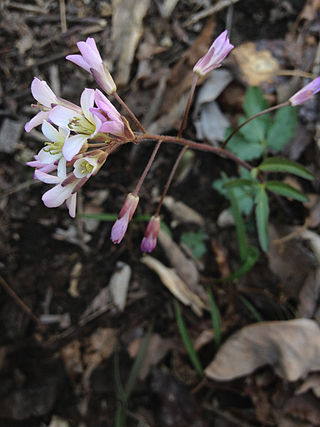
Nasturtium is a genus of a small number of plant species in the family Brassicaceae commonly known as watercress or yellowcress. The best known species are the edible Nasturtium officinale and Nasturtium microphyllum. Nasturtium was previously synonymised with Rorippa, but molecular evidence supports its maintenance as a distinct genus more closely related to Cardamine than to Rorippasensu stricto.

Cardamine concatenata, the cutleaved toothwort, crow's toes, pepper root or purple-flowered toothwort, is a flowering plant in the family Brassicaceae. It is a perennial woodland wildflower native to eastern North America.

Schoepfiaceae is a family of flowering plants recognized in the APG III system of 2009. The family was previously only recognized by few taxonomists; the plants in question usually being assigned to family Olacaceae and Santalaceae.

Delairea is a genus of flowering plants within the family Asteraceae. Currently, it only features two species: Delairea odorata from Southern Africa, and the recently discovered Delairea aparadensis from Southern Brazil, which is critically endangered. D. odorata formerly belonged to the genus Senecio as Senecio mikanioides.

Kleinia petraea is a species of flowering plant in the genus Kleinia and family Asteraceae which was previously considered to be a species of Senecio. Native to Kenya and Tanzania, it is colloquially known as creeping jade, trailing jade or weeping jade due to its resemblance to the unrelated Jade plant. It is grown as a garden plant as a groundcover or in hanging baskets.
Ihsan Ali Al-Shehbaz is an American botanist who works as adjunct professor at University of Missouri-St. Louis and Senior Curator at Missouri Botanical Garden. Al-Shehbaz's primary area of interest is Brassicaceae and The Durango Herald called him "a world expert on taxonomy of the family". A 2008 publication of the United States Fish and Wildlife Service called him "the world's authority on species in the genus Lesquerella". The author abbreviation "Al-Shehbaz" is attached to the numerous botanical taxa he has identified.

Seidlitzia stocksii is a shrub species of the family Amaranthaceae.

Glaucocarpum is a monotypic plant genus containing the single species Glaucocarpum suffrutescens, a rare species of flowering plant in the mustard family known by the common names toad-flax cress, shrubby reed-mustard, Uinta Basin waxfruit and waxfruit mustard. It is endemic to Utah in the United States, where it is known only from Duchesne and Uintah Counties. It is threatened by habitat degradation and destruction. It is federally listed as an endangered species of the United States.

Cardamine angustata is a perennial forb native to the eastern United States, that produces white to pink or purple flowers in early spring.

Arjona patagonica is a species of flowering plant in the family Schoepfiaceae native to southern South America.

Allenrolfea is a genus of shrubs in the family Amaranthaceae. The genus was named for the English botanist Robert Allen Rolfe. There are three species, ranging from North America to South America.

Selenia aurea, the golden selenia, is a flowering plant in the mustard family (Brassicaceae). It is endemic to the southern United States where it grows in sunny prairies, barrens, and glades of Arkansas, Kansas, Missouri, and Oklahoma. It flowers between March and May.
Weberbauera is a genus of flowering plants in the crucifer family Brassicaceae, native to the central Andes; Peru, Chile, Bolivia, and Argentina.
Chilocardamum is a small genus of four herbaceous cress-like species of plants in the family Brassicaceae, only found growing in Patagonia, southern Argentina.

Polypsecadium is a genus of large herbaceous species of plants in the family Brassicaceae, found growing in South America. Most of the species were formerly classified in the genus Sisymbrium.
Alshehbazia is a monotypic genus of flowering plants belonging to the family Brassicaceae. It only contains one known species, 'Alshehbazia hauthalii'

Armoracia sisymbrioides is a species of flowering plant in the mustard family, Brassicaceae. It is native to Asia.
Ianhedgea is a monotypic genus of flowering plants belonging to the family Brassicaceae. The only species is Ianhedgea minutiflora.

Cardamine maxima is a species of flowering plant in the mustard family Brassicaceae.
Cardamine dissecta is a species of flowering plant in the mustard family Brassicaceae.













